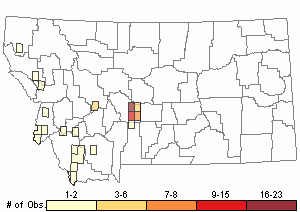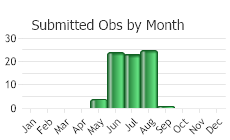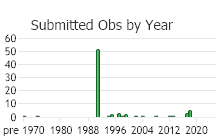View in other NatureServe Network Field Guides
NatureServe
Montana
Utah
Wyoming
Idaho
Wisconsin
British Columbia
South Carolina
Yukon
California
New York
Linear-leaf Fleabane - Erigeron linearis
State Rank Reason (see State Rank above)
Erigeron linearis is a peripheral species known from a few small and moderate-sized, localized occurrences. Almost all populations are on federally-managed lands or lands under conservation easement. However, development on adjacent lands may fragment some areas of suitable habitat. Two historical locations are also known. The occupied habitats and population are susceptible to negative impacts from invasive weeds.
General Description
Linearleaf Fleabane has unbranched stems that are 5-30 cm tall and which arise from a stout taproot and branched rootcrown. The mostly basal leaves are linear and 1-9 cm long. The bases of the stems and leaves are enlarged and straw-colored or purplish, and the herbage is covered with fine gray hairs. The flower heads are usually solitary at the ends of the stems. The involucral bracts are 4-7 mm long and are covered with long, appressed hairs and occasionally also with glands. The 15-45 yellow rays are 4-11 mm long and the yellow disk flowers are 3-5 mm long. There are 10-20 pappus bristles at the top of each achene.
Phenology
Flowering occurs from May to early June.
Diagnostic Characteristics
Linear-leaf fleabane is our only Erigeron with yellow ray flowers. Erigeron filifolius and E. ochroleucus also have narrowly linear leaves but the ray flowers are white or blue and and E. filifolius has more than one head per stem. Members of the genus Stenotus (formerly a part of Haplopappus) have yellow rays, but the involucral bracts are in 2-3 series of different height.
Species Range
Montana Range
Range Descriptions

 Native
Native
Range Comments
BC, MT south to CA, NV and UT (Lesica et al. 2012. Manual of Montana Vascular Plants. BRIT Press. Fort Worth, TX).
Observations in Montana Natural Heritage Program Database
Number of Observations: 77
(Click on the following maps and charts to see full sized version)
Map Help and Descriptions
Relative Density

Recency



 (Observations spanning multiple months or years are excluded from time charts)
(Observations spanning multiple months or years are excluded from time charts)
Habitat
Erigeron linearis occurs in dry, often rocky soil from the foothills up to moderate elevations, frequently with sagebrush (Heidel and Cooper 1998). Dominant species in its habitat include bluebunch wheatgrass and mountain big sagebrush (Artemisia tridentata ssp. vaseyana). Associated species and habitats vary widely. In the Scratchgravel Hills near Helena, it occupies two distinct habitats - one a midslope opening on a steep east-facing timbered hillside, and the other a gently southwest-facing lower slope in open rolling plains. In Beaverhead County, linear-leaf fleabane was found on granular, diabase-derived soil in rolling sagebrush steppe, where it occupied a disturbed opening dominated by Agropyron smithii, along with other species characteristic of disturbed areas, including Arenaria kingii, Bromus tectorum, Chrysopsis villosa, Haplopappus acaulis, Oxytropis sericea and Phlox bryoides. Other small populations in Beaverhead and Silver Bow counties were found in sparse vegetation.
National Vegetation Classification System Groups Associated with this Species
Shrubland
Sagebrush Shrubland
Grassland
Lowland - Prairie Grassland
Sparse and Barren
Sparse and Barren
Ecology
Linear-leaf fleabane is an herbaceous perennial. At one locality in Beaverhead County, Heidel and Vanderhorst (1996) speculated that the site may have been grubbed or burned, resulting in removal of the sagebrush cover. The low stature of this plant probably means that it responds positively to the disturbance of livestock grazing.
POLLINATORS The following animal species have been reported as pollinators of this plant species or its genus where their geographic ranges overlap:
Bombus bifarius,
Bombus centralis,
Bombus fervidus,
Bombus flavifrons,
Bombus huntii,
Bombus melanopygus,
Bombus mixtus,
Bombus rufocinctus,
Bombus occidentalis, and
Bombus insularis (Thorp et al. 1983, Wilson et al. 2010, Colla and Dumesh 2010, Koch et al. 2012).
Management
Leafy spurge and spotted knapweed threaten populations in the Scratchgravel Hills. Observations suggest that this species may respond positively to disturbance. Some populations might have been established through human activity, because the species is highly localized within what appears as extensive suitable habitat, in locations of historically intense mining activity.
Stewardship Responsibility
Threats or Limiting Factors
STATE THREAT SCORE REASON
Reported threats to Montana's populations of Linear-leaf Fleabane are primarily those associated with noxious weeds (MTNHP Threat Assessment 2021). Direct competition with Spotted Knapweed (Centaurea stoebe), Dalmatian Toadflax (Linaria dalmatica), Leafy Spurge (Euphorbia virgata) is impacting many populations, and some infestations are severe. Resulting habitat loss is exacerbated by chemical herbicide application, and surviving individuals are exposed to spray. Information on the scope, severity, and/or timing of these and other threats is needed.
References
- Literature Cited AboveLegend:
 View Online Publication
View Online Publication Colla, S.R. and S. Dumesh. 2010. The bumble bees of southern Ontario: notes on natural history and distribution. Journal of the Entomological Society of Ontario 141:39-68.
Colla, S.R. and S. Dumesh. 2010. The bumble bees of southern Ontario: notes on natural history and distribution. Journal of the Entomological Society of Ontario 141:39-68. Koch, J., J. Strange, and P. Williams. 2012. Bumble bees of the western United States. Washington, DC: USDA Forest Service, Pollinator Partnership. 143 p.
Koch, J., J. Strange, and P. Williams. 2012. Bumble bees of the western United States. Washington, DC: USDA Forest Service, Pollinator Partnership. 143 p. Lesica, P., M.T. Lavin, and P.F. Stickney. 2012. Manual of Montana Vascular Plants. Fort Worth, TX: BRIT Press. viii + 771 p.
Lesica, P., M.T. Lavin, and P.F. Stickney. 2012. Manual of Montana Vascular Plants. Fort Worth, TX: BRIT Press. viii + 771 p. MTNHP Threat Assessment. 2021. State Threat Score Assignment and Assessment of Reported Threats from 2006 to 2021 for State-listed Vascular Plants. Botany Program, Montana Natural Heritage Program, Helena, Montana.
MTNHP Threat Assessment. 2021. State Threat Score Assignment and Assessment of Reported Threats from 2006 to 2021 for State-listed Vascular Plants. Botany Program, Montana Natural Heritage Program, Helena, Montana. Thorp, R.W., D.S. Horning, and L.L. Dunning. 1983. Bumble bees and cuckoo bumble bees of California (Hymenoptera: Apidae). Bulletin of the California Insect Survey 23:1-79.
Thorp, R.W., D.S. Horning, and L.L. Dunning. 1983. Bumble bees and cuckoo bumble bees of California (Hymenoptera: Apidae). Bulletin of the California Insect Survey 23:1-79. Wilson, J.S., L.E. Wilson, L.D. Loftis, and T. Griswold. 2010. The montane bee fauna of north central Washington, USA, with floral associations. Western North American Naturalist 70(2): 198-207.
Wilson, J.S., L.E. Wilson, L.D. Loftis, and T. Griswold. 2010. The montane bee fauna of north central Washington, USA, with floral associations. Western North American Naturalist 70(2): 198-207.
- Additional ReferencesLegend:
 View Online Publication
View Online Publication
Do you know of a citation we're missing? Harvey, S.J. 1990. Responses of steppe plants to gradients of water soil texture and disturbance in Montana, U.S.A. Ph.D. Thesis. Bozeman, MT: Montana State University. 34 p.
Harvey, S.J. 1990. Responses of steppe plants to gradients of water soil texture and disturbance in Montana, U.S.A. Ph.D. Thesis. Bozeman, MT: Montana State University. 34 p. Heidel, B.L. and J. Vanderhorst. 1996. Sensitive plant species surveys in the Butte District, Beaverhead and Madison Counties. Unpublished report to the Bureau of Land Management. Montana Natural Heritage Program, Helena, Montana.
Heidel, B.L. and J. Vanderhorst. 1996. Sensitive plant species surveys in the Butte District, Beaverhead and Madison Counties. Unpublished report to the Bureau of Land Management. Montana Natural Heritage Program, Helena, Montana. Heidel, B.L. and S.V. Cooper. 1998. Botanical survey of the Scratchgravel Hills, Lewis & Clark County, Montana. Unpublished report to the Bureau of Land Management. Montana Natural Heritage Program, Helena, Montana. 44 pp. + appendices.
Heidel, B.L. and S.V. Cooper. 1998. Botanical survey of the Scratchgravel Hills, Lewis & Clark County, Montana. Unpublished report to the Bureau of Land Management. Montana Natural Heritage Program, Helena, Montana. 44 pp. + appendices. Lesica, P., M.T. Lavin, and P.F. Stickney. 2022. Manual of Montana Vascular Plants, Second Edition. Fort Worth, TX: BRIT Press. viii + 779 p.
Lesica, P., M.T. Lavin, and P.F. Stickney. 2022. Manual of Montana Vascular Plants, Second Edition. Fort Worth, TX: BRIT Press. viii + 779 p. Mincemoyer, S. 2005. Surveys of significant plant resources and related vegetation types for the Butte Office of the Bureau of Land Management. Montana Natural Heritage Program, Helena, MT. 11 pp + appendices.
Mincemoyer, S. 2005. Surveys of significant plant resources and related vegetation types for the Butte Office of the Bureau of Land Management. Montana Natural Heritage Program, Helena, MT. 11 pp + appendices. Quire, R.L. 2013. The sagebrush steppe of Montana and southeastern Idaho shows evidence of high native plant diversity, stability, and resistance to the detrimental effects of nonnative plant species. M.Sc. Thesis. Bozeman, MT: Montana State University. 124 p.
Quire, R.L. 2013. The sagebrush steppe of Montana and southeastern Idaho shows evidence of high native plant diversity, stability, and resistance to the detrimental effects of nonnative plant species. M.Sc. Thesis. Bozeman, MT: Montana State University. 124 p.
- Web Search Engines for Articles on "Linear-leaf Fleabane"





